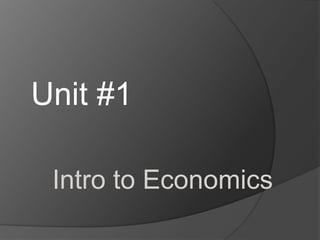This document provides an introduction to economics, including its key concepts and the American economic system. It discusses that economics is the study of how people use limited resources to satisfy unlimited wants. It also covers the three basic economic questions of what, how, and for whom to produce. Additionally, it explains the characteristics of the American mixed economy, including limited government role, freedom of enterprise and choice, the profit incentive, private property rights, and competition.




![Answering the 3 basic economic questions in a Market Economy [i.e., U.S.]What to produce?What should we devote our resources to?What do the consumers want?How to produce?What methods should be used in production?What is most efficient?For whom to produce?Who can afford the product?](https://image.slidesharecdn.com/peunit1studentnotes-110828132657-phpapp02/85/Pe-unit-1-student-notes-5-320.jpg)

























